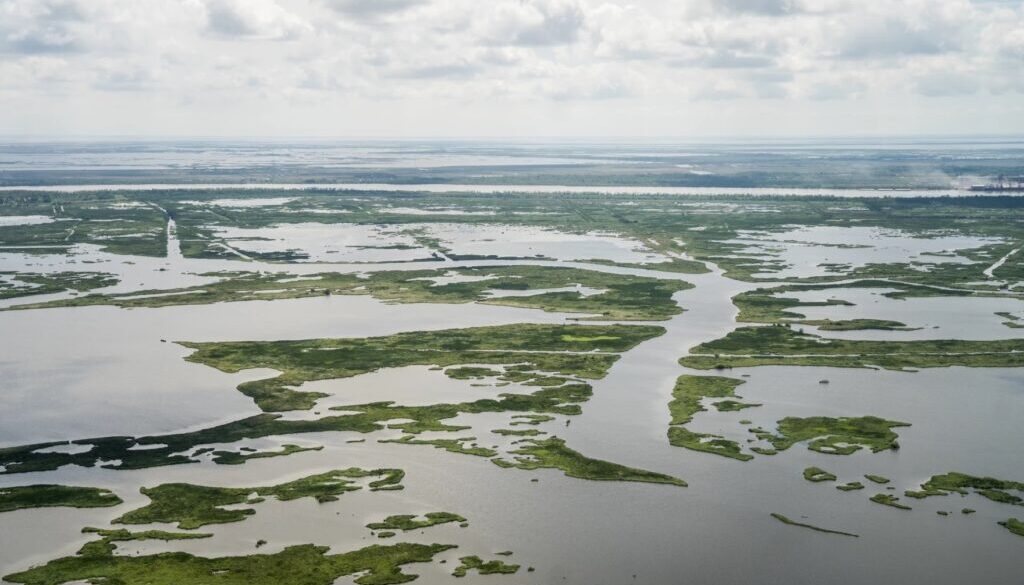A new bid to safeguard Mississippi River amid growing environmental concerns
By Madeline Heim, Milwaukee Journal Sentinel
A proposal to create a federal funding program to protect the Mississippi River is back in front of Congress.
Democratic Sen. Tammy Baldwin of Wisconsin announced Wednesday that she plans to introduce the Mississippi River Restoration and Resilience Initiative in the Senate. Democratic Rep. Betty McCollum of Minnesota will bring the same bill forward in the House.
The proposal is nearly the same as one introduced by McCollum in 2021. It’s modeled after programs that protect other major bodies of waters across the US, like the Great Lakes Restoration Initiative and the Chesapeake Bay Program.
Advocates for the Mississippi River argue that the river is long overdue to have its own such program. Millions of Americans rely on it for drinking water, commerce and recreation, and its floodplains provide food and habitat for hundreds of fish and wildlife species. But it’s facing a multitude of challenges, from extreme weather to habitat loss to persistent agricultural and industrial pollution. That pollution contributes to the dead zone in the Gulf of Mexico, which last year was almost as big as Yellowstone Park.
Even in the past few years, the river has experienced the impacts of a changing climate, said Kelly McGinnis, executive director of the Mississippi River Network. Last spring, communities along the upper river saw near-record floodwaters, bookended by severe droughts that slowed shipping traffic to a crawl.
“If anything, since (this legislation) was first introduced, the conditions of the world we live in just keep showing us that there is an urgent need to address these problems, and they’re not solving themselves,” McGinnis said.
Baldwin told the Journal Sentinel that she hears concerns from constituents on Wisconsin’s western border about flooding and invasive species on the river. Representing a state that touches both the river and the Great Lakes, she said she’s seen the success of the Great Lakes Restoration Initiative and that it is “so appropriate and needed that we have a Mississippi River restoration initiative.”
A public opinion study released in October by the University of Missouri Journalism School, which houses the Mississippi River Basin Ag & Water Desk, found that the majority of respondents in the basin support such a plan.
In a news release, McCollum said there’s more work to be done for the Mississippi, “with decades of pollution having damaged the river’s ecosystem, and new challenges emerging for communities up and down the corridor.”
“From the northernmost headwater communities, to where I grew up along the river in South St. Paul, to the Middle Mississippi where it meets the Ohio River, and all the way down to the Mississippi Delta — the health of this great river deserves our attention and our investment,” she said.
A holistic plan
The Mississippi River Restoration and Resilience Initiative, nicknamed MRRRI, is meant to create a holistic program for the river — which touches 10 states — that would catalog its problems and figure out solutions.
The program would be housed within the US Environmental Protection Agency, and program funding would fall into four main buckets. Those include improving water quality, restoring habitats, reducing the presence of invasive species and creating natural infrastructure to protect against flood damage.
In the two years after its passage, EPA staff would meet key stakeholders along the river — municipalities, tribal governments, nonprofit organizations and universities — to craft an action plan, identifying which projects should receive funding. A portion of those funds would be directed to disadvantaged or low-income communities and communities of color, which disproportionately experience the effects of runoff pollution, low-quality drinking water and severe weather events.
Alongside the action plan would be a science plan, which would create three regional hubs at universities in the 10 border states for research on the river’s challenges.
The bill is largely similar to the one proposed in 2021, with a few key differences. First, it doesn’t appropriate a specific amount of money the program would receive — formerly about $300 million annually, in McCollum’s original version.
Second, 5% of whatever funding is allocated would be set aside for tribal organizations and governments, and managed by the Bureau of Indian Affairs. Whitney Clark, executive director of the Minnesota-based nonprofit Friends of the Mississippi River, said that change was made after speaking with tribes involved in the Great Lakes Restoration Initiative, which made an adjustment in 2020 to give tribes more direct control over funding.
McGinnis said removing the appropriations language could slow the speed of the bill’s impact if passed, but that she understands it may be a necessary change to bring some lawmakers on board and give the bill a stronger chance of passage. If that happens, she said, assigning a funding mechanism to the plan would be the next step.
A “range of big challenges”
The Great Lakes program, on which the Mississippi River bill is based, is widely considered a success story. To date, it has funded over 7,500 projects totaling more than $3 billion and it got a billion-dollar boost from the Bipartisan Infrastructure Law. Republicans and Democrats alike have voted to increase funding for the initiative nearly every year since it passed.
But the political climate under which this bill is being introduced is different, and bipartisanship is rare. Though McCollum’s original bill was endorsed by close to 150 organizations, it failed to garner any Republican support and did not have a companion bill in the Senate.
Baldwin said she plans to have discussions with senators from across the aisle whose states border the river, and that she believes bipartisan support is possible.
“It’s gone from a bill just in the House to now being bicameral, and I think the obvious next step is to make it bipartisan,” she said.
Its supporters feel that its reintroduction will help remind people of the threats the river faces.
In Minnesota, for example, Clark, with Friends of the Mississippi River, is worried about invasive carp swimming upriver into his state’s waters. He believes the program could help states work together to control them.
“The river has been facing a range of big challenges that frankly, we’re not measuring up against,” he said. “We’re concerned that unless we begin to change these trends, the river will not be healthy in our lifetime.”
This story is a product of the Mississippi River Basin Ag & Water Desk, an independent reporting network based at the University of Missouri in partnership with Report for America, funded by the Walton Family Foundation.
(Featured photo is an aerial view of broken wetlands in Plaquemines Parish, Louisiana, where the Mississippi River meets the sea. Credit: Kezia Setyawan, WWNO)
 EWG
EWG


